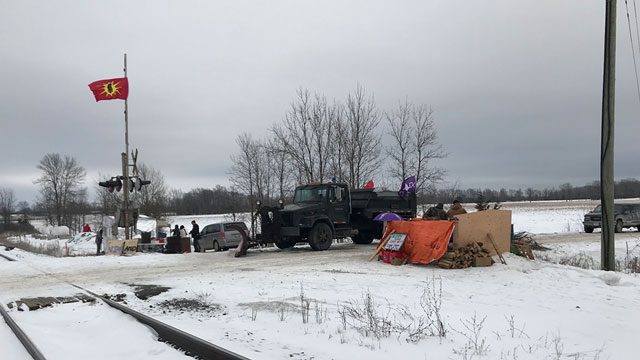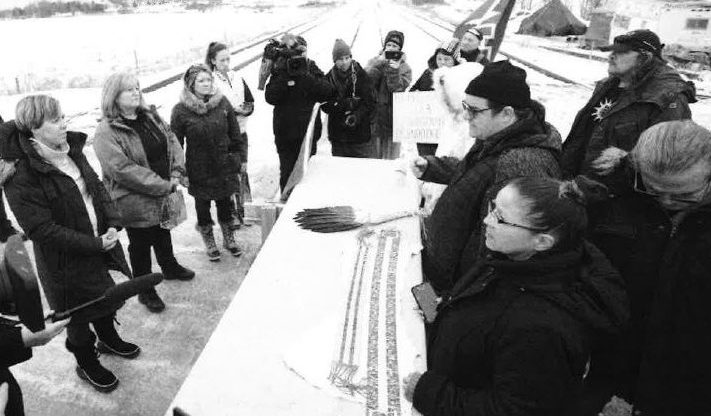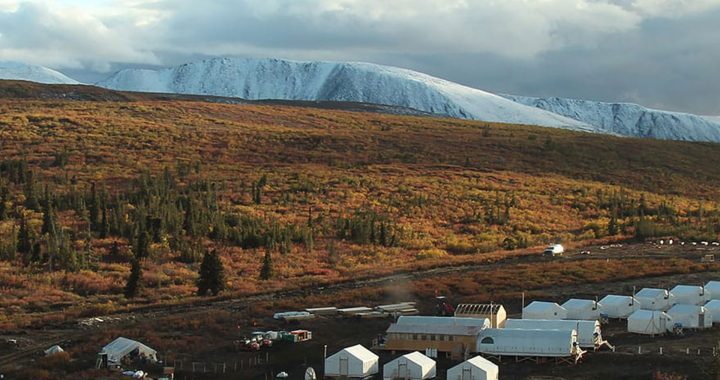
The most significant train stoppage in support of the Wet’suwet’en hereditary chiefs began when a Mohawk man was spotted talking on his phone at the Wyman Road rail crossing just before 11 a.m. on Feb. 6, according to court documents.
The Mohawk man was identified as Seth LeFort, who was observed again at the same location with another person, Brandi Maracle, at 2:05 p.m.
“They are not blocking the tracks but stated they would wait and see what the people wanted to do,” according to court records of the encounter at the Canadian National Railway’s mainline.
An hour later CN Rail alleges ‘a number of individuals’ launched a blockade of the mainline.
“At that time there were approximately eight individuals blocking the Main Line by igniting a metal fire barrel at or near the CN railway tracks. They also had stacks of firewood stored in a nearby truck,” wrote CN police Const. Michael Knorz in a sworn affidavit Feb. 7, based on second-hand information provided to him by colleague Const. Phillip Cyr.
“Constable Cyr left the area of Wyman Crossing and moved back to a safer location and continued to monitor the area.”
No photos were included in the affidavit to support this specific claim.
“The situation continued to escalate throughout the afternoon. Constable Cyr indicated to me that, at approximately 5:15 p.m., the protestors parked a large dump truck with a snowplow on the railway tracks and thus traffic on the entire Main Line was suspended,” wrote Knorz.
Knorz said Cyr was later approached by two people in a black truck who said if the dump truck was removed they would use a back hoe to rip up tracks. “We’re not playing,” the people allegedly said.
Then the Mohawk Warrior flag was hung from the upright crossing arm and 15 more people showed up.
As an exhibit to support this claim, Knorz provided an online CBC News article that was published at 6:09 p.m.
The story’s main photo shows the dump truck adjacent to the tracks. The story says the same. It also includes another photo showing the crossing completely clear.
Ontario Provincial Police spokesperson Bill Dickson is quoted in the CBC story, saying, “We know there has been activity adjacent to the rail line.”
Knorz alleged the truck was then moved at 7:02 p.m., “but parked in a location so that it could be easily returned to the rail line.”
By 10 p.m. Knorz alleged the rail was “further blocked” with a large couch, pick-up truck and a dark car.
There are no exhibits to support this claim.
The following day Knorz wrote he started his shift at 7 a.m. and the demonstrators had “maintained the Blockade of the Wyman Crossing. The Dump truck is still on the railway tracks.
“It is my impression that they will be positioned at this location for the long-term.”
This is what CN told a judge Feb. 7 when it filed for an ex parte interim injunction against John and Jane Doe, meaning the claim was argued only before the judge and CN.
CN told Justice William Chalmers, of Toronto’s Commercial List court, the “blockage of the track has been continuous since 5:15 [p.m.] Feb 6/20. This has prevented the movement of freight and passenger trains on the main lines.”
Besides the CBC article, CN provided no other evidence of a blockade, while other media reports show the demonstrators camped out next to the tracks just beyond the arms that lower when a train passes.
Chalmers granted the interim injunction the same day but the OPP didn’t enforce it. A week later CN was back in court seeking to extend the injunction. The following comes from what it submitted in court in support of the extension. The demonstration is referred to as a blockade throughout the court filings.
Court records show that on Feb. 9 it observed “the group dynamic have changed and they seem more aggressive”.
The following day an encounter between an unidentified member of law enforcement and LeFort took place to discuss the injunction. According to court records, tensions were high during the exchange.
“Seth was very curt and sharpe [sic]. Very clear no trains will be going through. Lots of firewood dropped off, there will be a smash up and blood on the tracks. 10-12 people present,” according to an exhibit filed in court documenting daily log of encounters entitled: Wet’suet’en Solidary Protest/Involved Persons.
The log was provided to CN Rail by the OPP.
The table identifies each person law enforcement spoke with and their date of birth.
Then CN provides the only photo in any of its court filings that clearly shows the Mohawks on the tracks.
“A photograph was taken showing protestors standing by a long table that has been placed in the middle of Wyman Road Crossing. Indigenous cultural items, including two wampum belts, were placed on the long table. A protestor is holding a Mohawk Warrior flag,” wrote Knorz in this second affidavit, sworn Feb. 12.
There’s also media on the tracks, as well as members of OPP who were meeting with the Mohawks. The 113-page affidavit doesn’t mention this. Only a brief description of the encounter is found in the daily log filed separately.

(This photo was submitted as an exhibit by CN Rail to show Mohawks on the tracks)
“Offered gift of tobacco and peaceful dialogue. Jake accepted the tobacco. Media was present. WAMPUM Belt ceremony, Injunction read,” according to the log.
“Jake” was identified as Jacob Sharp, as well as his date of birth, in the log.
Knorz also provides media reports as exhibits; they refer to the demonstration as a “blockade”.
“The blockade also continues to cause safety issues due to the number of vehicles and individuals at or near the railway tracks. As I stated in my previous affidavit, I am concerned that the ongoing blockage could result in an accident leading to severe physical injury,” said Knorz.
On Feb. 14 Chalmers extended the injunction “until vacated or varied” by the court.
“To carry out the protest, the blockade, the protesters have moved vehicles and other items onto the rail crossing,” wrote Chalmers in his handwritten endorsement, with the word “protest” struck out and replaced with “blockade”. “The rail line and right of way is the property of CN Rail.”
He said CN was being used as a “pawn” by the protesters in their “unlawful blockade.”
Chalmers was also critical of the OPP for “failing” to enforce the injunction.
“If the police are not prepared to do so … the police should provide the names [of protesters] to CN Rail so it can pursue a civil remedy,” wrote Chalmers.
According to the information provided to Chalmers, which was attached to his Feb. 14 order, the log listed the names of 11 demonstrators identified by the OPP.
Chalmers scheduled a hearing for Mar. 24 “seeking to find these [11] individuals in contempt” of his Feb. 7 order referring to the log.
APTN asked LeFort if he had seen any of the exhibits filed in court.
“We have not seen anything but the injunction papers themselves,” he wrote in an email.
APTN couldn’t confirm with LeFort why no one from the protest attended the Feb. 14 hearing.

(Photo shows where the Mohawks set up camp next to the tracks Feb. 12.. Photo courtesy: Annette Francis)
CN also filed two affidavits by employee Josh Ellis, a rail traffic control manager based in Edmonton.
Ellis explained approximately $350 million in commodities is shipped between Toronto and Montreal every day.
The Wyman Road crossing near Tyendinaga basically sits right in the middle.
CN cited two cases as precedents to obtain the injunction and both include rail protests during Idle No More seven years ago.
A CN spur-line was physically blocked for approximately two weeks in Sarnia. In that case, CN took the spokesman of the action, Ron Plain, to court for contempt.
The other case involved the Mohawks in Tyendinaga. During that action the Mohawks triggered the arms at the crossing to lower as if a train was going by. That sent an alert to CN that halted trains for several hours.
Justice David Brown ordered the injunction in both cases. APTN previously reported Brown used to represent CN Rail as a lawyer and also acted as a witness for the company in the United States.











In my opinion, Ontario and Ottawa are just escalating this situation in an attempt to avoid any actual action on either reconciliation or climate change.